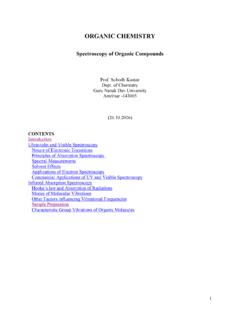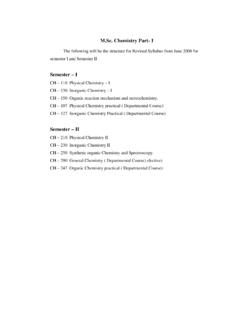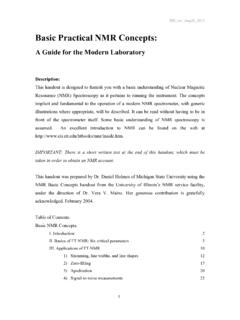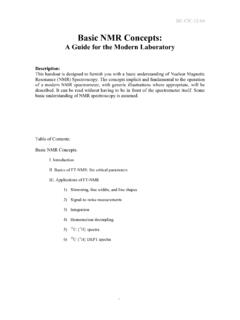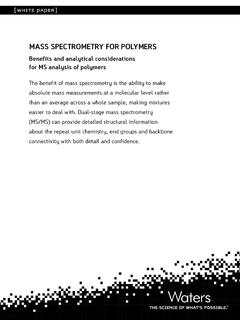Transcription of Module 1: Fundamentals of Spectroscopy
1 Module 1: Fundamentals of Spectroscopy Mod. #1-1 MASSACHUSETTS INSTITUTE OF TECHNOLOGY Department of Chemistry Introduction to Experimental Chemistry Module 1: Fundamentals OF Spectroscopy It s amazing how much we can learn about molecules and materials by shining light on them! In Spectroscopy , we use light to determine a tremendous range of molecular properties, including electronic, vibrational, rotational, and electron and nuclear spin states and energies. From this information, we can often deduce a great deal of additional insight, including: Molecular identities what is the sample composed of? Molecular conformations, geometries, and sizes Chemical equilibria Effects of liquid or solid-state surroundings on molecules Dynamics, including the rates of chemical reactions, interchange among different molecular conformations, relaxation of molecular excited states, photosynthetic energy transfer, protein folding, etc.
2 We also can use light to control, as well as study, some molecular properties and events. In photochemistry, light may be used for generation of new chemical products, sometimes with selectivity or yields that cannot otherwise be achieved. We depend on a wide range of photophysical processes like those in photosynthesis and vision. Modern laser sources allow the use of intense light pulses to manipulate materials and molecules in unique ways, inducing phase transitions, ablating material, initiating nuclear fusion, and so on. Laser micromachining and CD recording are examples of applications of these processes.
3 There are a great many ways in which Spectroscopy may be conducted. In some cases, light of different wavelengths is shined on a sample and the wavelengths that get absorbed most strongly are measured. In others, you let the sample first absorb light and then measure the wavelength of light emitted. In yet others, you shine a pulse (or a sequence of pulses) of light on the sample and measure various time-evolving responses. There are countless variations on these themes, some routine and commercialized, others highly specialized and carried out only in scattered research labs around the world.
4 Through an understanding of the general principles of Spectroscopy , you can understand the way most spectroscopic measurements work and begin to think creatively about the broad range of spectroscopic possibilities. Module 1: Fundamentals of Spectroscopy Mod. #1-2 Purpose This Module is designed to introduce the basic concepts of Spectroscopy and to provide a survey of several of the most common types of spectroscopic measurement. You will conduct the following measurements. UV-VIS (ultraviolet-visible) Spectroscopy of electronic states Fluorescence Spectroscopy of electronic states IR (infrared) vibrational Spectroscopy NMR ( nuclear magnetic resonance ) Spectroscopy of nuclear spin states In most cases, you will be able to see the insides of the spectrometers and develop an understanding of how they work.
5 You will use your spectra for chemical identification, study of electronic properties of organic molecules and semiconductor quantum dots, assessment of how electronic energy levels are affected by their surroundings in a solid, and other purposes. In the process of conducting the experiments, you will learn methods of sample preparation, operation of the spectrometers, and interpretation of the various types of spectra that you will record. Safety Chemicals: The chemicals involved in this experiment should be handled with care to avoid harm to your or your colleagues. These include deuterated solvents such as acetone-d6 or chloroform-d3 that are used for NMR Spectroscopy so that the signals from protons in the compounds of interest are not obscured by protons of the solvent.
6 Glass: In preparing NMR samples, you will use glass pipettes and NMR sample tubes. In placing a rubber bulb on the pipette or a plastic cap on the sample tube, the experimenter should hold the tube immediately below the point of attachment to avoid breakage of the glass. magnetic Fields: The field generated by an NMR magnet can have deleterious effects on watches (battery-powered watches with liquid crystal displays are an exception), magnetic credit cards (VISA, AmEx, etc.), and similar items. When working in the vicinity of an NMR spectrometer, leave these items in an alternate location.
7 The magnetic field can also influence cardiac pacemakers and other medical devices. Discuss any such devices with your instructor and take the necessary precautions. Reading 1. Hore, P. J. nuclear magnetic resonance , Oxford University Press, Oxford, 1998. 2. Mohrig, ; Hammond, ; Schatz, ; Morrill, Techniques In Organic Chemistry Freeman: New York, 2003. Chapter 19. 3. Pavia, D. l.; Lampman, G. M.; Kriz, G. S. Introduction to Spectroscopy : A Guide for Students of Organic Chemistry, Saunders: Fort Worth, 1996. Chapters 3-5. Module 1: Fundamentals of Spectroscopy Mod. #1-3 General Background Light and Matter What happens when a sample is irradiated by light?
8 From introductory chemistry courses, you might have a quantum mechanical picture of light absorption, which emphasizes that light energy comes in quantized units, called photons, and that a molecule s energy also comes in quantized units or quanta , so when a molecule absorbs a photon, it takes up the photon s energy to reach an excited state of some sort. Your picture of light absorption might look like this. Figure 1. Optical absorption. Both of these depictions get one crucial element correct: conservation of energy. The photon energy does indeed get turned into molecular energy. Also, since molecular energy is quantized, there are only molecular excited states at certain discrete energy levels.
9 The photon energy has to be equal to the difference E between some pair of energy levels of the molecule in order for absorption to occur. There are many types of states that these energy levels could correspond to, but in this Module you will only consider electronic, vibrational, and spin states. Exercise 1. What are the names, values, and units of h and ? How about , , and ? What are their values for visible and infrared light and for the MIT radio station frequency? Figure 1 also contains some grave simplifications. Its biggest problem is that it suggests that the molecule is in a static, or (in quantum mechanical terms) stationary, excited state after irradiation.
10 The accuracy of this description varies, but in your NMR experiments you will see graphic evidence that it is not complete. In those experiments, you will irradiate a sample with a pulse of radiation at radio frequencies (RF) and you will measure the time-dependent, oscillating state of the proton spins in the sample, long after the RF pulse is gone. Similarly, time-dependent molecular vibrations that occur during and after irradiation by an IR pulse can be measured, although their time scale is so fast that ultrashort laser pulses are required to observe the individual vibrational oscillations.










